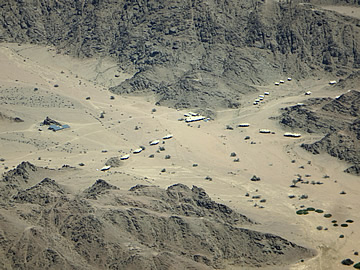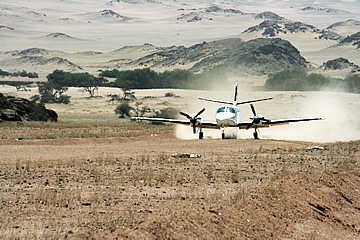

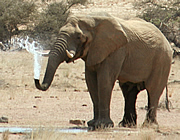
Hoanib Skeleton Coast Camp looked a fabulous place and we were almost guaranteed to see desert-adapted elephants - we were not disappointed.
And there were many other beautiful animals here in this very remote wilderness.
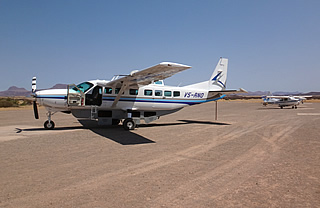
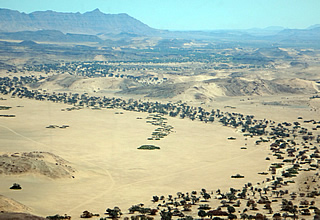
We flew from Doro Nawas air strip to Hoanib via Desert Rhino Camp - the airstrips at the camps were even more basic than Doro Nawas! The runways are just graded dirt and quite bumpy but perfectly serviceable.
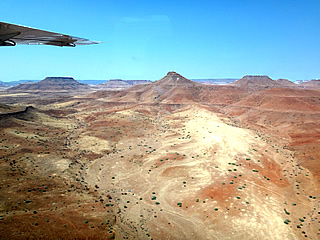
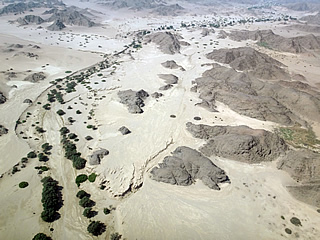
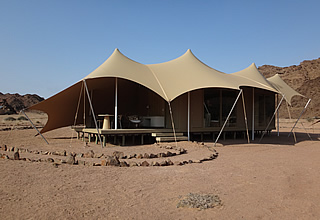
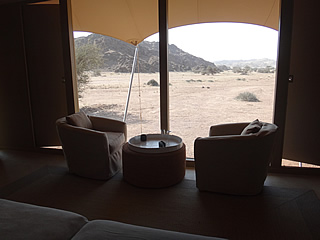
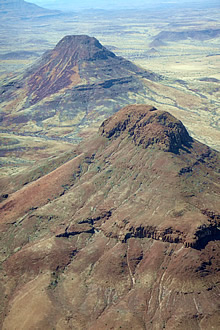
The landscape below was extremely dry, any sign of water marked by trees and shrubs. The further towards the coast we flew, the drier it seemed to become and the vegetation more sparse. There were vast tracts of wilderness and arriving at the airstrip was quite surreal - literally nothing to be seen apart from a small hut and the dirt runway.
We were met at the airstrip and driven to Hoanib. The "camp" is the epitome of luxury in the desert. Having only been open a few weeks they were still finding their feet a little but the welcome was very friendly and we were given a cool drink and introductory information in the huge open "tent" furnished with comfortable sofas. Right on cue a huge bull elephant ambled up to the waterhole in front of us!
Our accommodation - one hesitates to call such luxury a tent - was amazing. Very large with a lovely bathroom and a huge bed facing a window with a view right down the plain past the waterhole and on to the mountains. Outside was a decking area with more comfortable sofas and a fridge. There were air horns in the rooms - this is an open camp so the wild animals are free to come and go around the tents as they please - and we were told to call for an escort at dawn and dusk or if we needed through the night.
There are only eight tents, spaced well apart, in this camp which is actually not too far from the Skeleton Coast in a very remote area of the Kaokoveld. The camp runs trips to the coast but as we'd driven up quite a length of it and seen one wreck and many magnificent dunes already on our trip we wanted to concentrate on the wildlife.
As we unpacked, the bull elephant wandered around ripping branches from trees before ambling off down the valley - a fabulous start to our stay here
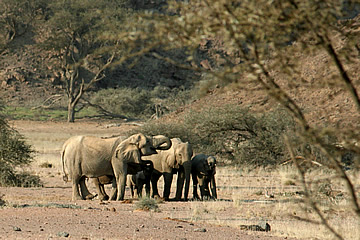
Later when we returned to main area to meet our guide a group of elephants were at the waterhole illuminated by a soft evening light.
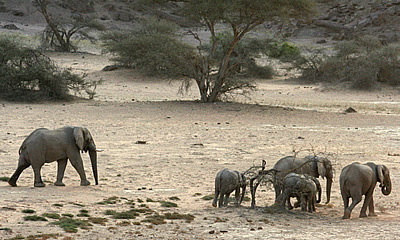
That evening we and the only two others at the camp - a really nice English couple John and Linda - were taken on an evening game drive. But this was a game drive with a difference - we got out of the 4x4 not far from where the guide knew there to be a herd of elephants and climbed a spur of a low, rocky mountain so that we could look down on them. The climbing surface was none too stable but we all managed without mishap. It was a wonderful experience, the elephants in their natural habitat completely unaware of us.

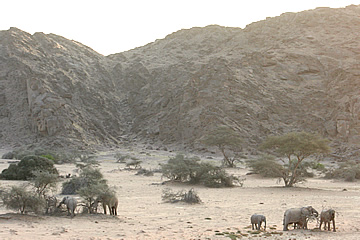
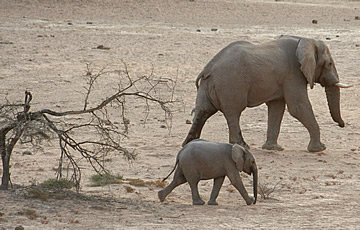
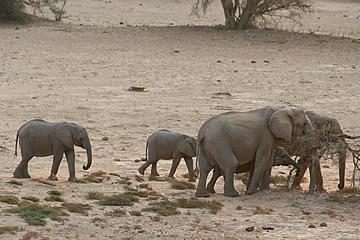
As the elephants moved off we returned to the vehicle and the guide drove on to where he suspected they would go - a wide dry river bed. The guide must have been studying the habits of the elephants in the area because sure enough there they were, just approaching the bank which led steeply down to the river bed.

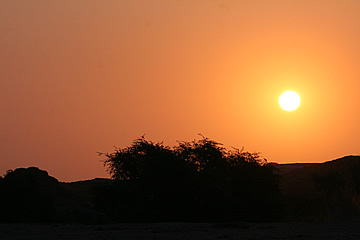
We got out again and approached on foot. I wasn't too sure of the safety of this - one of the elephants was a huge male and he'd spotted us, but the guide said as long as we stayed together, presenting what looked like one large animal, we would be safe.
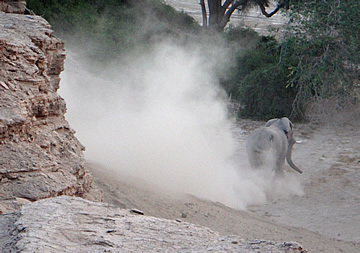
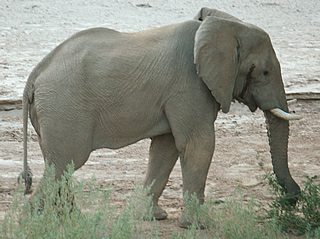
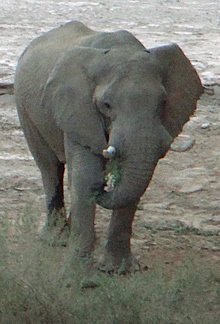
We got so close to this elephant. He watched us out of the corner of his eye as he reached the river bank and then turned to look at us, shaking his head, then turned back and walked - or rather, slid - down to the river bed.
It was only when I looked at the photographs that I realised this elephant was in musth - a highly aggressive state driving the elephant to mate. The two tell-tale signs are a secretion from the gland behind the eye and urine leakage which is often seen as a stain on the inside back leg - this elephant showed both these signs. This is not an animal you want to get up close and personal with! Once it was down on the river bed we were relatively safe though.
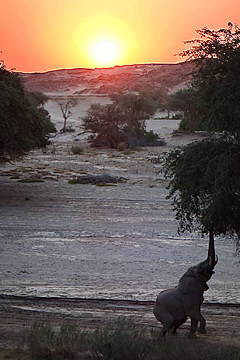
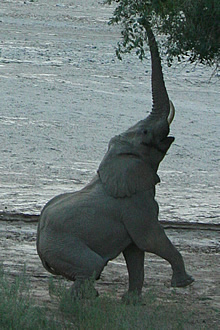
We watched as he stretched to reach succulent leaves high in a tree until the sun went down and it was really too dark to see.
This image of the blazing setting sun, orange sky and magnificent elephant is one I will always remember - the photographs don't really do justice to the beauty of the scene.
Then I got bundled up in a poncho as it had become very cold and a wind had sprung up as soon as the sun disappeared and we had G&Ts and nibbles from the back of the 4x4 - very civilised!
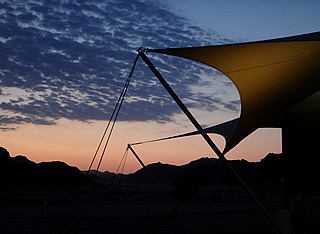
The next day we had a 7a.m. start for a full day on safari.
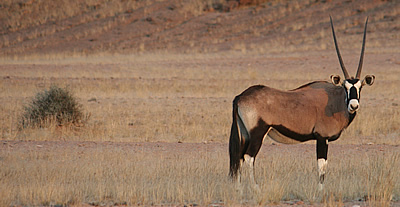
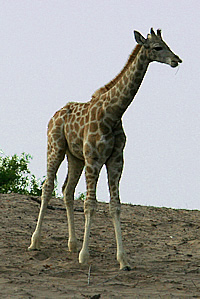
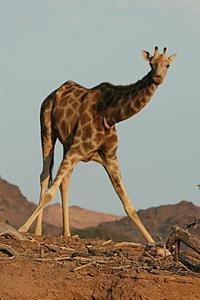
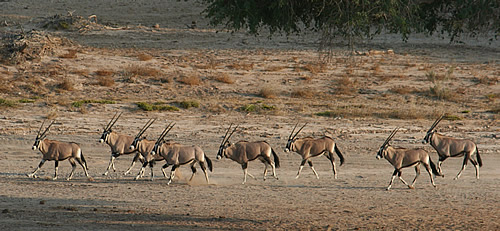
We saw lots of beautiful oryx - also known as gemsbok - and many other antelope, as elsewhere there were many springbok in the region.
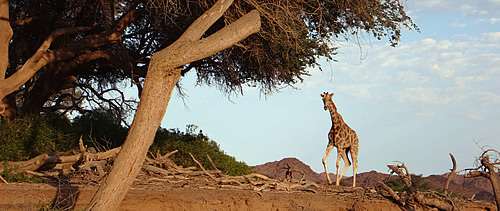
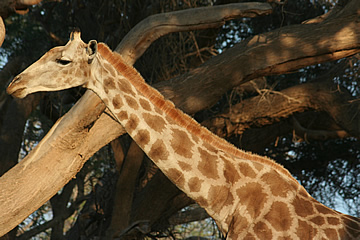
Early in the day we spotted a very young giraffe at the side of a dry river bed. On the opposite bank the mother kept an eye on us but didn't seem too concerned by our presence.
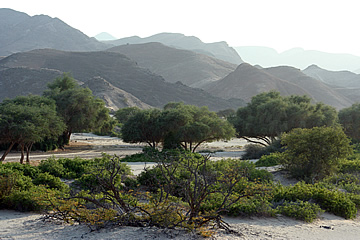
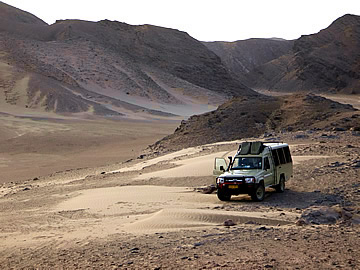
To begin with we were following a dry river bed - the camp is sited at the confluence of two tributaries of the Hoanib. There was a relatively high amount of vegetation here for the animals to feed on.
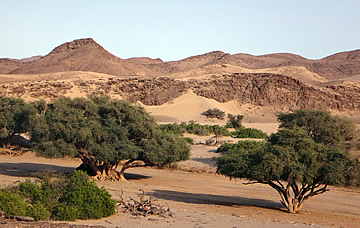
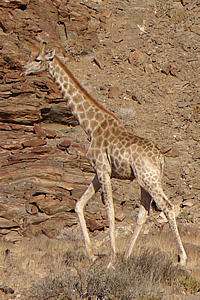
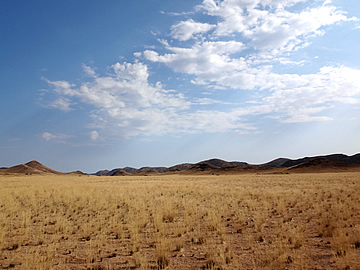
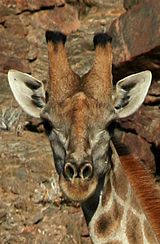
Then we climbed and moved off into a much more arid landscape before reaching a vast expanse of grassland.
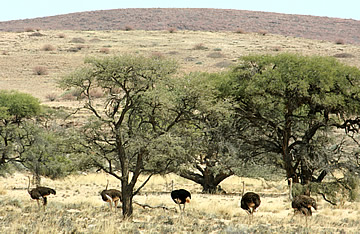
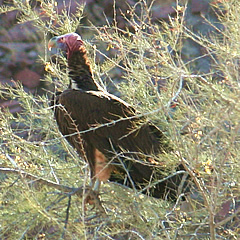
We drove over 50km through grassy plains and over sandy plateaus.
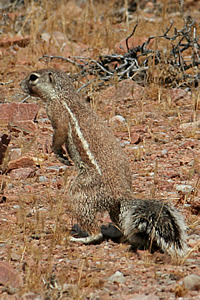
We spotted a lappet-faced vulture in a tree - a vulnerable species - more giraffe, baboons and springbok along the way, a few shy mountain zebra on a cliff looking warily at us over the edge!
Eventually we came to a point where we were climbing a steepish rise and suddenly a huge number of animals began to stampede from the top, which we couldn't see. It was quite a sight and we were speculating as to what could have caused it when we topped the rise and came to a deserted waterhole. We realised then that it was the grinding of the vehicle engine which had spooked the animals.
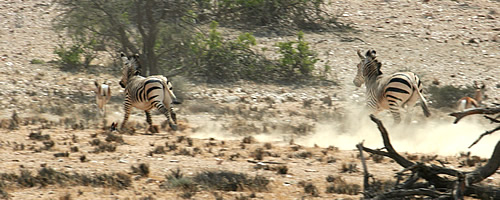
The guide knew the waterhole was there. It would have been better if we had made a wide circle to come to a point where we could observe the animals drinking, rather than heading directly for it. I was rather upset that we'd scared the animals away from their water. Mountain zebra, springbok and oryx in large numbers stopped a short distance away and turned to observe us. Hopefully as soon as we left they would have returned to the waterhole.


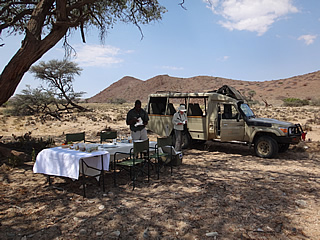
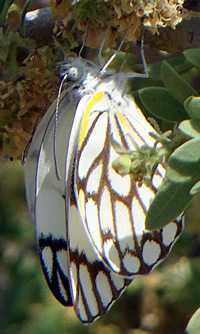
Lunch was beautifully set out on a white tablecloth-covered table in the shade of a tree, a curious giraffe watching us from some distance.
It was a long drive back but the landscape is starkly beautiful and ever-changing: barren rocky slopes with widely-spaced hardy thorn bushes, grassy plains dotted with trees and lined with mountains, a rocky gorge where we saw a solitary kudu with beautiful twisted antlers and black-tailed mongooses. The mongooses were very funny, running up the mountain then peeping over the rocks to watch us - they were much too fast for photographs.
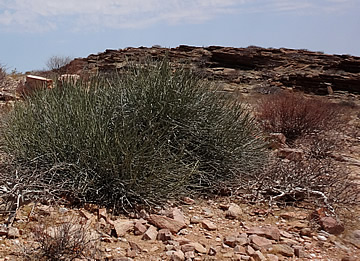
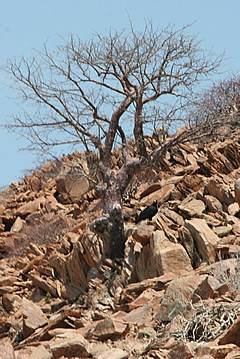
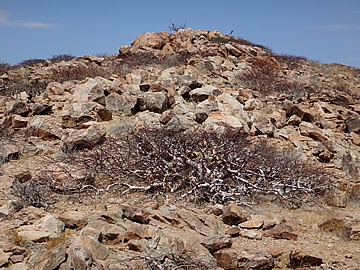
Just after lunch we came upon a solitary Verreaux's Eagle in its classic rocky habitat. It eyed us warily before flying off.

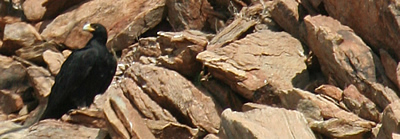

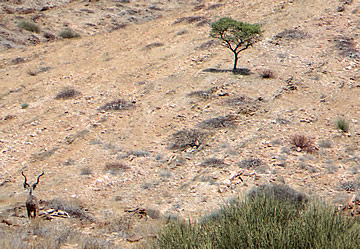
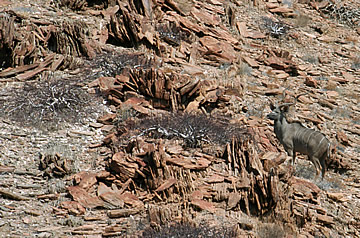
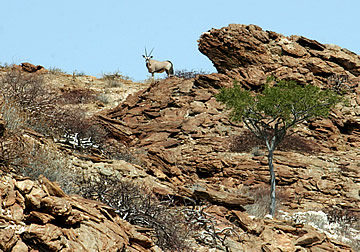
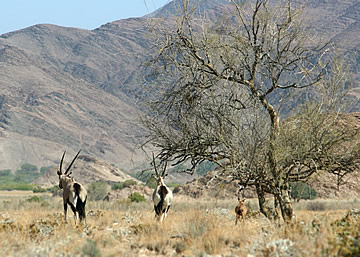
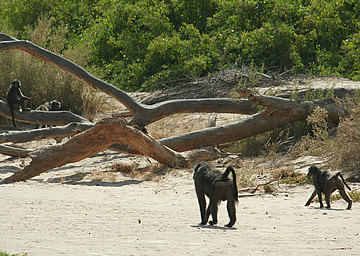
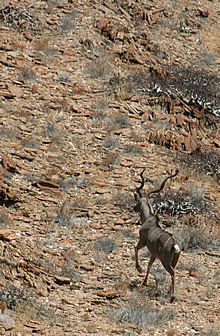
We saw quite a lot of young animals. As well as the baby giraffe there were baby baboons and a beautiful baby oryx with its parents.
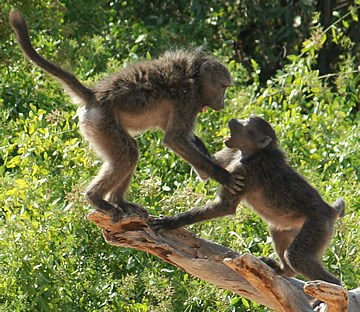
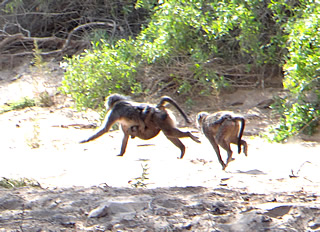
During the heat of the day there were few animals in evidence, except under shady trees and at water holes. Later they began to come out into the open again to feed.

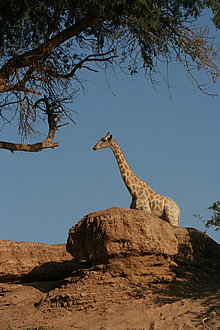
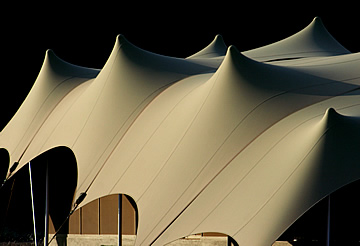
We saw no elephants during the day but this didn't seem to be elephant country - we didn't even see any dried droppings. The best place to see the elephants seems to be closer to the camp.
We got back to Hoanib at around 6 p.m. - we'd been out eleven hours and were all very tired. Greeted by refortifying G&Ts and very welcome ice-cold damp towels.

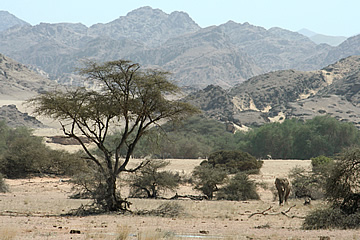
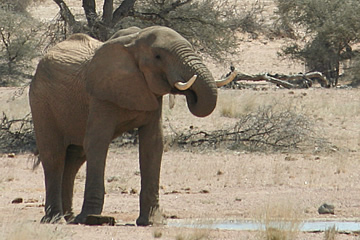
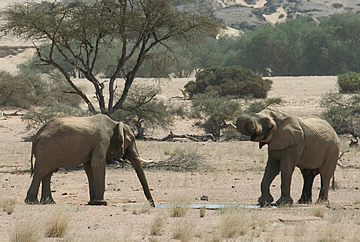
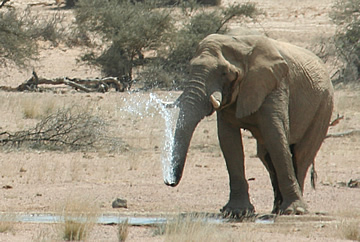
On our final day - we were leaving after lunch - we decided to spend the morning at Hoanib.
In the very early morning I scanned the broad valley in front of us through binoculars. Then one of the most memorable moments: a large bull elephant wandered into sight from the far left. He made his way in a very leisurely fashion across, swinging his trunk and heading for the opposite side of the valley. It was a wonderful sight, another I'll always remember - there have been quite a few on this trip!
As we went to breakfast we noticed fog at the end of the valley making its way in - apparently this is quite common. A flight to the coast had to be cancelled because of fog at the destination and the two guests were driven there instead. Hopefully the weather had cleared enough for them to fly back rather than having to undertake the long journey by four wheel drive again.
After breakfast the fog had cleared and we sat on our shaded deck. Just after 11 a large bull elephant ambled up to the waterhole, closely followed by an even bigger male, then two females and two babies and two more - I was ecstatic!
The second bull to arrive was in musth and was probably the same elephant we'd seen at the dry river bed on our first evening at Hoanib. The first bull elephant was extremely wary of him.
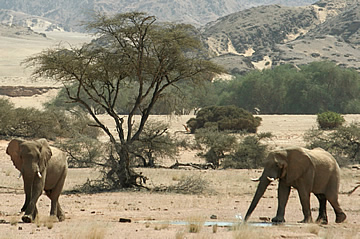
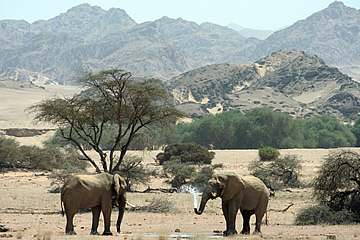
The elephants stayed around the camp for the rest of the time we were there, drinking at the waterhole, spraying each other and feeding. A poor little jackal couldn't get a look-in for a drink. This was the only time I have heard elephants trumpeting and also the deep rumbling sound that they make - it was wonderful.
It was absolutely blissful just to sit, with no-one else around, and watch these elephants congregate and interact.

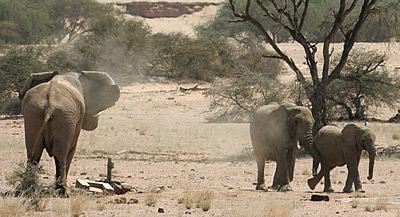
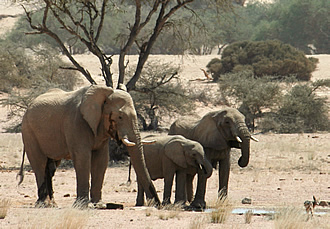
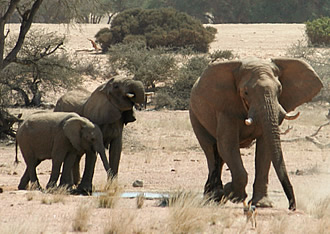

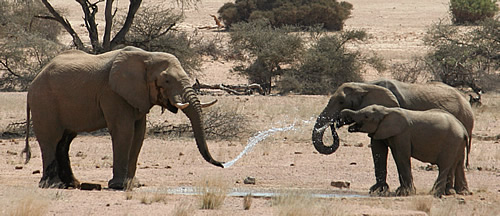
We continued to watch them while we had lunch and afterwards they wandered up towards our tent, grazing the tough vegetation, toward the top end of the valley.
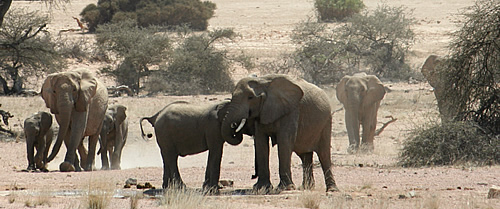
The staff were all out watching too, though one of the young waitresses said she was afraid of elephants, they were so big. They said that though elephants often come to the waterhole they then usually go back down the valley and it was very unusual for them to stay and graze.
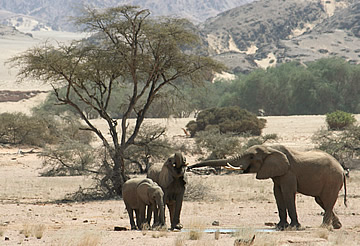

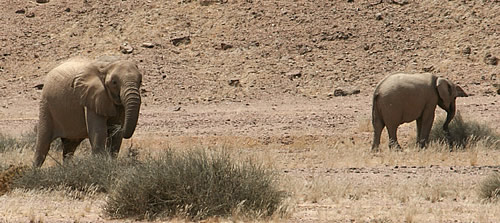
As we left the elephants were going off around a rock face near the tents, it was as if they'd stayed just long enough to bid us farewell.
I couldn't have wished for a better end to our stay.

